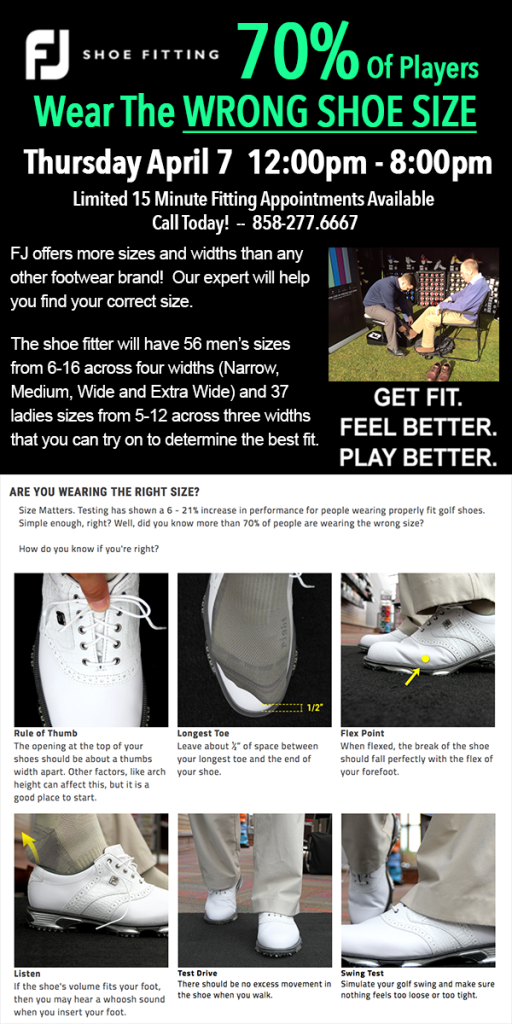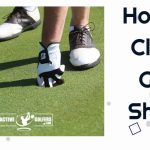Golf shoes should fit snugly without being too tight. They must offer stability and comfort during your swing.
Properly fitting golf shoes enhance performance and comfort on the course. Ill-fitting shoes can cause blisters, discomfort, and affect your balance. Always try on shoes with your golf socks to ensure the best fit. Walk around and mimic your swing to check for any pressure points or slipping.
A good fit includes a thumb’s width of space in the toe box and a secure heel. Remember, golf shoes stretch slightly over time, so don’t choose a size that feels too loose initially. Investing time in finding the right fit can greatly improve your game and overall enjoyment on the course.
Importance Of Proper Fit
Choosing the right golf shoes is essential for every golfer. The Importance of Proper Fit can’t be overstated. Properly fitting golf shoes enhance performance and prevent injuries. Let’s explore why this is crucial.
Enhanced Performance
Properly fitted golf shoes improve your game. They provide better stability and balance. Stable feet lead to a more consistent swing. Well-fitted shoes also offer better traction, reducing the risk of slipping. This helps in playing on wet or uneven terrains.
Injury Prevention
Ill-fitting shoes can cause many foot problems. These include blisters and calluses. They also lead to more serious injuries like plantar fasciitis. Properly fitted shoes support your feet and reduce these risks.
Here is a quick comparison:
| Proper Fit | Ill-Fitting Shoes |
|---|---|
| Enhanced stability | Risk of slipping |
| Better traction | Foot injuries |
| Comfortable play | Blisters and calluses |
Choosing the right size and fit can make or break your game. Always ensure your golf shoes fit perfectly.

Credit: stadiumgolfcenter.com
Measuring Your Feet
Properly fitting golf shoes are essential for comfort and performance. To ensure the best fit, you must measure your feet accurately. This involves checking the length, width, and arch type of your feet. Let’s break it down.
Length And Width
The length of your foot is crucial for the right fit. Use a ruler or a foot measuring device. Stand on a flat surface with your heel against a wall. Measure from the wall to the tip of your longest toe. Record this measurement in inches or centimeters.
The width of your foot is equally important. Measure the widest part of your foot. Usually, it’s the ball of your foot. Wrap a measuring tape around this area. Note down the measurement. Compare these measurements with the shoe size chart of the brand you prefer.
| Foot Length (in inches) | Foot Width (in inches) | Shoe Size |
|---|---|---|
| 10 | 4 | 8 |
| 10.5 | 4.2 | 9 |
| 11 | 4.3 | 10 |
Arch Type
Your arch type affects the fit of your golf shoes. There are three main arch types:
- Low Arch (Flat feet)
- Medium Arch (Normal arch)
- High Arch
To determine your arch type, do a simple wet test. Wet your foot and step on a piece of paper. Observe the imprint:
- If you see most of your footprint, you have a low arch.
- If you see about half of your arch, you have a medium arch.
- If you see only a thin line, you have a high arch.
Choose golf shoes that offer proper support for your arch type. This prevents discomfort and improves your game. Check shoe descriptions for arch support details.
Types Of Golf Shoes
Golf shoes come in various styles to suit different needs. Choosing the right type can improve your game. Let’s explore the options.
Spiked Vs. Spikeless
Spiked golf shoes provide excellent traction. They are ideal for wet conditions. They help prevent slipping on the course. Traditional spikes are metal, but most are now soft spikes.
Spikeless golf shoes have rubber nubs instead of spikes. They offer more comfort. They are versatile and can be worn off the course. They are best for dry conditions.
Materials And Construction
Golf shoes are made from different materials. Each material offers unique benefits.
| Material | Benefits |
|---|---|
| Leather | Durable, water-resistant, and molds to your foot. |
| Synthetic | Lightweight, breathable, and often more affordable. |
| Gore-Tex | Waterproof, breathable, and ideal for wet weather. |
Construction also matters. Look for sturdy soles and good arch support. A well-constructed shoe enhances stability and comfort.

Credit: www.footjoy.com
Trying On Golf Shoes
Finding the perfect fit for golf shoes is essential. It impacts your game and comfort. Trying on golf shoes correctly ensures you pick the best pair. Follow these tips to make sure your golf shoes fit perfectly.
Right Time Of Day
Try on golf shoes in the afternoon. Feet swell during the day, so this ensures a better fit. If you try shoes in the morning, they might feel tight later.
Socks And Inserts
Wear the socks you plan to use during your golf games. This helps in getting the right fit. Golf socks are thicker than regular socks, so this is crucial.
Bring any inserts or orthotics you use. Place them in the shoes while trying them on. This ensures the shoes fit well with your inserts.
| Aspect | Importance |
|---|---|
| Trying Shoes in the Afternoon | Feet are at their largest |
| Wearing Golf Socks | Ensures correct fit |
| Using Inserts or Orthotics | Guarantees comfort |
Check if the shoes fit snugly but not too tight. Your toes should have some room to move. The heel should stay in place without slipping.
Walk around the store to test the shoes. Make sure they are comfortable and supportive. Take your time to find the perfect fit.
- Try on shoes in the afternoon
- Wear your golf socks
- Use your inserts or orthotics
- Ensure a snug fit
- Walk around to test comfort
Key Fit Features
Choosing the right golf shoes is crucial for your performance. The fit of your golf shoes can affect your game. Here are key fit features to consider for optimal comfort and performance.
Toe Room
Your toes need enough space to move. The toe box should be spacious. This prevents blisters and discomfort. A tight toe box can hinder your swing. Ensure there’s a thumb’s width space between your toes and the shoe’s front.
Heel Fit
The heel should fit snugly. This prevents slipping and provides stability. A loose heel can cause blisters. Ensure the heel grips well without being too tight. Walk around to test the heel fit.
Common Fit Issues
Ensuring your golf shoes fit correctly is essential for comfort and performance. Many golfers face common fit issues. These issues can affect your game and comfort level. Let’s explore some of these common fit issues.
Too Tight
Wearing golf shoes that are too tight can cause several problems. Tight shoes can lead to discomfort and even pain. Here are some signs your golf shoes are too tight:
- Redness or blisters on your feet
- Pain in your toes or heel
- Feet feeling cramped or squeezed
To avoid these issues, ensure there’s enough space in the toe box. Your toes should wiggle freely. Also, check that the shoe’s width matches your foot’s width.
Too Loose
Golf shoes that are too loose can also cause problems. Loose shoes can affect your stability and swing. Here are some signs your golf shoes are too loose:
- Feet sliding inside the shoes
- Lack of support during your swing
- Blisters from friction
To prevent these issues, ensure the shoes fit snugly around your midfoot. You should not feel any heel slippage. Check if the laces provide enough support.
Here’s a quick comparison of the symptoms:
| Issue | Symptoms |
|---|---|
| Too Tight | Redness, blisters, pain, cramped toes |
| Too Loose | Sliding feet, lack of support, blisters |
Addressing these common fit issues ensures comfort and better performance on the course.
Adjusting For Comfort
Comfort is key when wearing golf shoes. Proper adjustment can make a big difference. Ensuring your golf shoes fit well can improve your game. Here are some tips to help you adjust for comfort.
Lacing Techniques
Lacing techniques affect how your golf shoes fit. Proper lacing can offer better support. There are different ways to lace your shoes:
- Criss-Cross Lacing: The most common method. It balances pressure evenly.
- Loop Lacing: Good for high arches. It adds extra support in the middle.
- Lock Lacing: Prevents heel slippage. It ensures a snug fit around the ankle.
Experiment with these methods to find what suits you best.
Breaking Them In
New golf shoes can be stiff. Breaking them in makes them more comfortable. Follow these steps to break in your shoes:
- Wear them around the house for short periods.
- Gradually increase the time you wear them.
- Walk short distances to start.
- Use them for practice sessions before wearing them in a game.
Breaking in your shoes ensures they mold to your feet.
| Technique | Benefit |
|---|---|
| Criss-Cross Lacing | Even pressure distribution |
| Loop Lacing | Extra middle support |
| Lock Lacing | Prevents heel slippage |
Maintaining Your Golf Shoes
Maintaining your golf shoes is crucial for longevity and performance. Proper care ensures your shoes look great and perform well. Follow these simple tips to keep your golf shoes in top shape.
Cleaning Tips
Regular cleaning extends the life of your golf shoes. Here are some steps to keep them clean:
- Remove dirt and grass after each round.
- Use a soft brush to clean the soles.
- Wipe the uppers with a damp cloth.
- For stubborn stains, use mild soap and water.
- Dry your shoes at room temperature.
Avoid using harsh chemicals. They can damage the material. Regular cleaning keeps your shoes looking fresh and new.
Storage Advice
Proper storage is essential for maintaining your golf shoes. Follow these tips:
- Store your shoes in a cool, dry place.
- Avoid direct sunlight. It can cause fading.
- Use shoe trees to maintain their shape.
- Keep your shoes in a breathable bag.
- Rotate your shoes to prolong their life.
Correct storage prevents wear and tear. It helps your shoes last longer and perform better.

Credit: www.footjoy.com
Frequently Asked Questions
What Size Should Golf Shoes Be?
Golf shoes should fit snugly without pinching. There should be about half an inch of space from your longest toe to the end of the shoe.
How Tight Should Golf Shoes Fit?
Golf shoes should fit snug but not too tight. They should allow some wiggle room for your toes and provide proper support.
Do Golf Shoes Stretch Over Time?
Yes, golf shoes can stretch slightly over time. However, they shouldn’t rely on stretching for a proper fit. They should fit well from the start.
Should Golf Shoes Have Arch Support?
Yes, golf shoes should have good arch support. This helps maintain balance and comfort during your swing and while walking the course.
Conclusion
Finding the perfect golf shoe fit enhances your game and comfort. Prioritize snugness without tightness. Ensure proper arch support and toe room. Test shoes with golf socks for accuracy. Remember, the right fit can improve performance and prevent foot issues.
Invest time in choosing the best fit for optimal golfing experiences.





